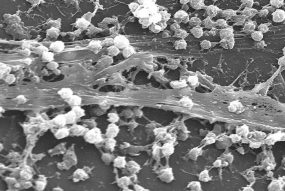Overview
- Overview
- Survey
- Structure
- Strategize
- Sustain
An indwelling urinary catheter is a thin, hollow tube inserted through the urethra into the urinary bladder to collect and drain urine. Once inserted, a balloon is inflated which keeps the catheter in place. An indwelling urinary catheter may be left in place for a period of days to weeks. The catheter is connected to a drainage bag that has a valve that can be opened to release urine as well as a separate port that can be used to collect a urine sample.
Urine culture stewardship is a multifaceted approach to ensure that urine cultures are:
- Performed only when appropriate indications are present in order to determine if treatment with antibiotics is indicated
- Collected, stored, and processed in a manner to best prevent contamination with microorganisms such as bacteria
This approach can be used in patients with and without indwelling urinary catheters in a variety of settings.

Scanning electron micrograph of S. aureus bacteria on the luminal surface of an indwelling catheter with interwoven complex matrix of extracellular polymeric substances known as a biofilm. Credit: CDC Public Health Image Library.
Indwelling urinary catheters quickly become colonized with microorganisms after insertion. These microorganisms produce proteins and other substances that are sticky and facilitate the formation of biofilms. These biofilms make it impossible to eradicate the bacteria even with antibiotics.
Bacteriuria is the presence of bacteria in urine. Because indwelling urinary catheters become colonized so easily, the incidence of bacteriuria is 3-7% per day. Nearly 100% of patients with urinary catheters will have bacteriuria after one month.
CA-ASB is the presence of bacteria in a urine sample due to bacterial colonization of the urinary tract and/or indwelling urinary catheter. CA-ASB does not cause symptoms and is not indicative of an infection that needs treatment with antibiotics in most patients; it is appropriate to treat ASB with antibiotics in pregnant women and in those undergoing certain invasive urological procedures.
A CAUTI occurs when germs (usually bacteria) enter the urinary tract through the urinary catheter and cause symptoms. CAUTIs have been associated with increased morbidity, mortality, healthcare costs, and hospital length of stay. They require treatment with antibiotics.
Distinguishing between CA-ASB and CAUTI is important to avoid unnecessary antibiotic use. Studies have shown that inappropriate treatment of patients with urinary catheters and ASB is widespread and can lead to unintended consequences.
Pitfalls of unnecessary antibiotic overuse are numerous and include
- Clostridioides difficile infections
- Colonization or infection with resistant bacteria
- Adverse drug events
Diagnosis and Treatment Guidelines from Infectious Disease Society of America (IDSA)
- Diagnosis, Prevention, and Treatment of CAUTI in Adults: 2009 International Clinical Practice Guidelines external icon
- Guidelines for the Diagnosis and Treatment of Asymptomatic Bacteriuria in Adultsexternal icon
Antibiotic Stewardship from CDC
Institutions that have implemented urine culture stewardship have reported:
Decreases in
- the number of total urine cultures ordered
- the number of ASB cases treated inappropriately
- costs related to overtreatment of ASB
- CAUTIs
No increases in
- patient adverse events
- Recommendation from the Choosing Wisely Campaign to reduce unnecessary medical tests, treatments, and procedures is an initiative of the American Board of Internal Medicine (ABIM) Foundation.
- Don’t perform urinalysis, urine culture, blood culture or C. difficile testing unless patients have signs or symptoms of infection. Tests can be falsely positive leading to over diagnosis and overtreatmentexternal icon
- Don’t obtain a urine culture unless there are clear signs and symptoms that localize to the urinary tract” in the long-term care setting external icon
- Coming Face-to-Face with Unneeded Testsexternal icon
- An Implementation Guide to Reducing Overtreatment of Asymptomatic Bacteriuriaexternal icon
Interventions to reduce inappropriate treatment of ASB while improving patient safety outcomes published in JAMA. - Urine Culture Practices in the ICU; Antibiotic Stewardship; Practical ICU Tools; Using Results from the Safety Culture Surveys (educational presentation)external icon
Appropriate urine culture collection in the intensive care unit (ICU), from the Agency for Healthcare Research and Quality (AHRQ) - CAUTI Change Packageexternal icon
Best practices, strategies and change concepts to reduce CAUTIs, developed by Hospital Improvement Innovation Network (HIIN) project led by the Centers for Medicare & Medicaid Services (CMS) and Partnership for Patients (PFP).
A method is presented for designing and implementing a urine culture stewardship program for hospitalized patients with indwelling urinary catheters.
This information could be used by a number of different healthcare personnel from infection preventionists looking to establish a multidisciplinary program across a healthcare system to individual providers searching for ideas to improve patient safety on a single unit.
Designing and implementing a urine culture stewardship program includes:
- Survey
current practices and outcomes to determine the potential benefit of urine culture stewardship for your institution. - Structure
your program for success. - Strategize
initiatives you can incorporate into your program - Sustain
reductions achieved with your program.
